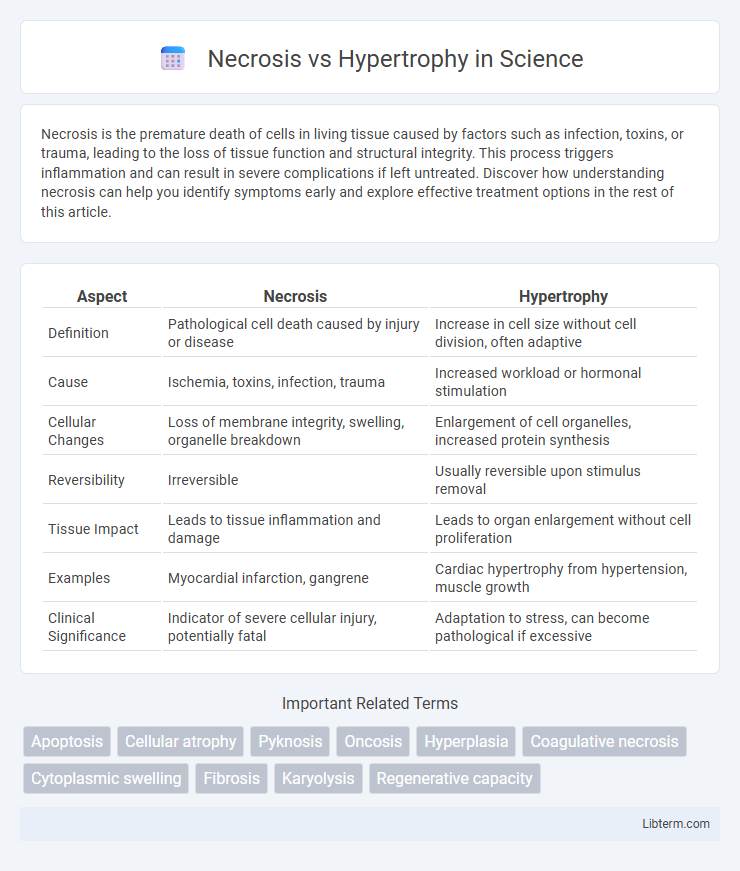Necrosis is the premature death of cells in living tissue caused by factors such as infection, toxins, or trauma, leading to the loss of tissue function and structural integrity. This process triggers inflammation and can result in severe complications if left untreated. Discover how understanding necrosis can help you identify symptoms early and explore effective treatment options in the rest of this article.
Table of Comparison
| Aspect | Necrosis | Hypertrophy |
|---|---|---|
| Definition | Pathological cell death caused by injury or disease | Increase in cell size without cell division, often adaptive |
| Cause | Ischemia, toxins, infection, trauma | Increased workload or hormonal stimulation |
| Cellular Changes | Loss of membrane integrity, swelling, organelle breakdown | Enlargement of cell organelles, increased protein synthesis |
| Reversibility | Irreversible | Usually reversible upon stimulus removal |
| Tissue Impact | Leads to tissue inflammation and damage | Leads to organ enlargement without cell proliferation |
| Examples | Myocardial infarction, gangrene | Cardiac hypertrophy from hypertension, muscle growth |
| Clinical Significance | Indicator of severe cellular injury, potentially fatal | Adaptation to stress, can become pathological if excessive |
Understanding Necrosis and Hypertrophy
Necrosis is the pathological death of cells due to injury, infection, or lack of blood supply, leading to tissue damage and inflammation. Hypertrophy involves the increase in cell size as an adaptive response to increased workload or hormonal stimulation, often observed in muscles and organs like the heart. Understanding the distinct mechanisms of necrosis and hypertrophy is crucial for diagnosing and treating various medical conditions such as ischemia and cardiac hypertrophy.
Key Differences Between Necrosis and Hypertrophy
Necrosis is the pathological death of cells caused by factors such as injury, infection, or toxins, resulting in inflammation and tissue damage, while hypertrophy is the adaptive increase in cell size due to stimuli like increased workload or hormonal signals, without cell death. Necrosis leads to loss of cell membrane integrity and triggers an immune response, whereas hypertrophy involves enhanced cellular function and protein synthesis to meet physiological demands. Key differences include the irreversible cell damage seen in necrosis versus the reversible and often beneficial cellular enlargement observed in hypertrophy.
Causes of Necrosis
Necrosis occurs primarily due to factors such as ischemia, toxins, infections, and trauma that lead to irreversible cell injury and death. Ischemia, characterized by inadequate blood supply, deprives cells of oxygen and nutrients, triggering necrotic pathways. Exposure to toxins and microbial infections introduces harmful agents that disrupt cellular integrity, while mechanical injury physically damages tissue, collectively causing necrosis.
Causes of Hypertrophy
Hypertrophy occurs primarily due to increased workload or stress on tissues, leading to enlargement of cells rather than an increase in their number. Common causes include chronic pressure overload, such as hypertension affecting cardiac muscle, and increased demand, like resistance training stimulating skeletal muscle growth. In contrast, necrosis results from irreversible cell injury caused by factors like ischemia, toxins, or trauma, leading to cell death rather than growth.
Cellular Mechanisms: Necrosis vs Hypertrophy
Necrosis involves uncontrolled cell death characterized by cell membrane rupture, release of intracellular contents, and subsequent inflammation, resulting from severe cellular injury or stress. Hypertrophy is a controlled cellular adaptation marked by an increase in cell size due to enhanced protein synthesis and organelle proliferation without cell division, typically in response to increased functional demand. These distinct cellular mechanisms highlight the pathological destruction in necrosis versus the physiological growth response seen in hypertrophy.
Clinical Manifestations of Necrosis
Necrosis presents clinically with localized pain, swelling, and signs of inflammation such as redness and warmth due to tissue death and inflammatory response. Patients may exhibit fever and elevated white blood cell counts as systemic reactions to necrotic tissue and potential infection. Over time, necrotic areas can develop ulcers or abscesses, leading to impaired function of the affected organ or tissue.
Clinical Manifestations of Hypertrophy
Hypertrophy clinically manifests as an enlarged organ or tissue due to increased cell size, often seen in the heart with elevated muscle mass causing thickened ventricular walls. Patients may experience symptoms such as exertional dyspnea, chest pain, or arrhythmias related to reduced cardiac compliance and impaired ventricular filling. Unlike necrosis, hypertrophy does not involve cell death but may predispose to heart failure or ischemic events if adaptive mechanisms are exceeded.
Diagnostic Approaches for Necrosis and Hypertrophy
Diagnostic approaches for necrosis primarily involve histopathological examination using tissue biopsies to identify cell death and structural disruption, alongside imaging techniques such as MRI or CT scans to assess affected areas. Laboratory tests measuring biomarkers like elevated lactate dehydrogenase (LDH) and creatine kinase (CK) levels help detect necrotic tissue damage. In contrast, hypertrophy diagnosis relies on imaging modalities including echocardiography or MRI to evaluate organ or tissue enlargement, supported by molecular assays measuring increased protein synthesis and gene expression indicative of cellular growth.
Implications for Treatment and Management
Necrosis involves irreversible cell death leading to tissue damage, requiring interventions such as debridement and strategies to control inflammation and prevent infection. Hypertrophy is characterized by reversible enlargement of cells in response to increased workload, often managed by addressing underlying causes like hypertension or exercise-induced stress. Treatment for necrosis prioritizes limiting further damage and promoting repair, while hypertrophy management focuses on modulating physiological stressors to prevent progression to pathological states.
Prognosis: Necrosis versus Hypertrophy
Necrosis often indicates irreversible cell injury with poor prognosis due to tissue death and loss of function, increasing the risk of organ failure and complications. In contrast, hypertrophy is typically a reversible adaptive response where cells enlarge to meet increased demand, generally associated with a more favorable prognosis when the underlying cause is managed. Prognostic outcomes vary significantly depending on the extent of necrosis or hypertrophy and the specific organ involved.
Necrosis Infographic

 libterm.com
libterm.com